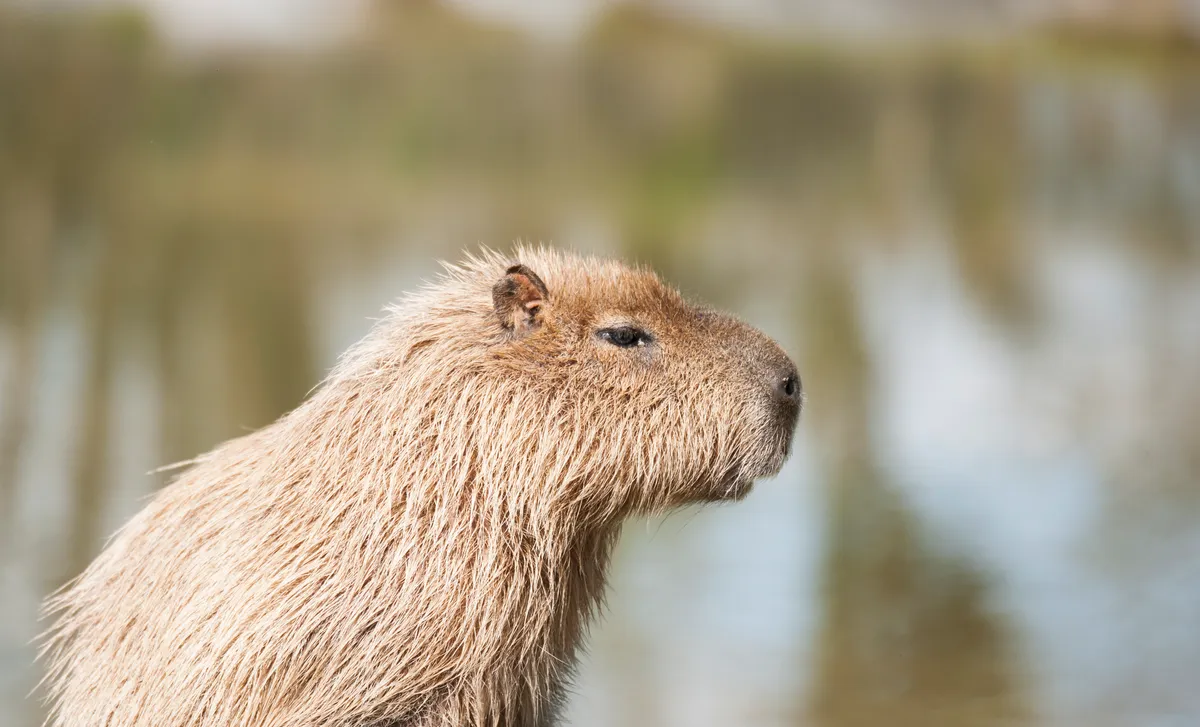What is a capybara
A capybara is a large rodent (about the size of a pig) and and a member of the genus Hydrochoerus.
What do capybaras look like?
Capybaras have short legs and an oblong body without a visible tail. Their bodies are covered with sparse rough fur that can range from reddish brown to light brown. Their head is large and elongated with a blunt muzzle. Capybaras have strong big incisors specialized for cutting grass, that grow continuously. Their eyes, ears and nostrils are on the top part of the head as an adaptation to their semi-aquatic lifestyle.
How big are capybaras?
The capybara is the largest living rodent in the world. Adults range between 35 and 65 kg (77 to 143 pounds).
What are capybaras related to?
Capybaras are closely related to guinea pigs and rock cavies. Since they are rodents, they are also related to rats, mice, beavers and squirrels.
Where do capybaras live?

Capybaras are native to South America. They can be found east of the Andes from Venezuela to the La Plata river basin in Argentina.
They are semi-aquatic and spend the majority of their time near water. They can inhabit gallery forests, marshes, wetlands, grasslands and savannahs, as long as they are within close proximity to surface water.
What do capybaras eat?
Capybaras are grazers and most of their diet consists on grasses, they also feed on sedges and aquatic plants. During the wet season, they are selective consumers that choose very palatable grasses. During the dry season, when resources are scarcer, they are less selective.
They also eat their own faeces, this behaviour is called cecotrophy and it is done during the mornings. Cecotrophy allows capybaras to re-ingest the products of their internal bacterial fermentation and therefore for nutrients to be better absorbed.
What eats capybaras?
The main predators of capybaras on land are big cats like jaguars (Panthera onca) and pumas (Puma concolor), and in the water they are predated by caimans. When they are young they have many more possible predators like foxes (Cerdocyon thous), birds (Polyborus plancus and Coragyps atratus), small cats (Leopardus pardalis) and snakes (Boa constrictor).
Another important predator of capybaras are humans, who hunt capybaras for meat and leather.
How can you differentiate between males and females?
Male capybaras have a more developed and easily visible snout gland on the top of their muzzle, which can be used to differentiate the sexes.
Are capybaras social animals?
Capybaras are a gregarious species. They live in groups of 5 to 100 individuals. With one dominant male, a few subordinate males and many females and pups. They are territorial and group members actively reject intruders. They all contribute to group defence through vigilance and females share the nursing of their young.
Not only are capybaras social amongst each other, but they tend to be accepting of the presence of other species. It is common to see capybaras with birds perching on their backs, which in many cases are eating ticks and other parasites off the capybara’s skin.
What is a baby capybara called?
Baby capybaras are called pups. There is usually a peak of births around the end of the wet season, but females are fertile all year round. They have the longest gestation period among rodents (5 months) and an average of four pups per litter.
What noises do capybaras make?
Vocal communication is common among capybaras. When they perceive a possible threat they produce a low-pitched bark as an alarm call. They also make a click sound as a contact call, and whine, cry or whistle when they become isolated from the group. In cases of fights or antagonism between individuals, they use agonistic calls like tooth-chattering and cackling.
Can capybaras swim? How long can they spend underwater?
Capybaras are semi-aquatic animals. They are very good swimmers. They have partially webbed feet and can stay underwater for up to 5 minutes.
They use the water as a shelter from the heat and from their land predators.
What is the scientific name of the capybara?
The capybara’s scientific name is Hydrochoerus hydrochaeris. It comes from Greek and can be roughly translated to “water pig”.
Are capybaras endangered? What threats do they face?
Capybaras are considered least concern according to IUCN and their main threat is hunting by humans for their leather and meat.
Images © Getty Images

